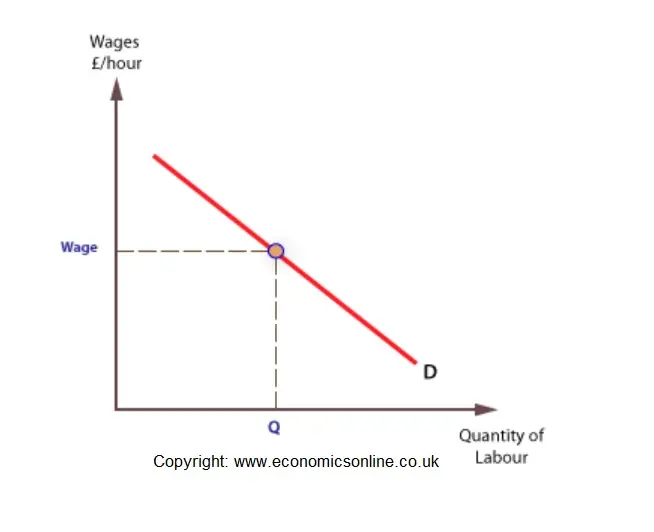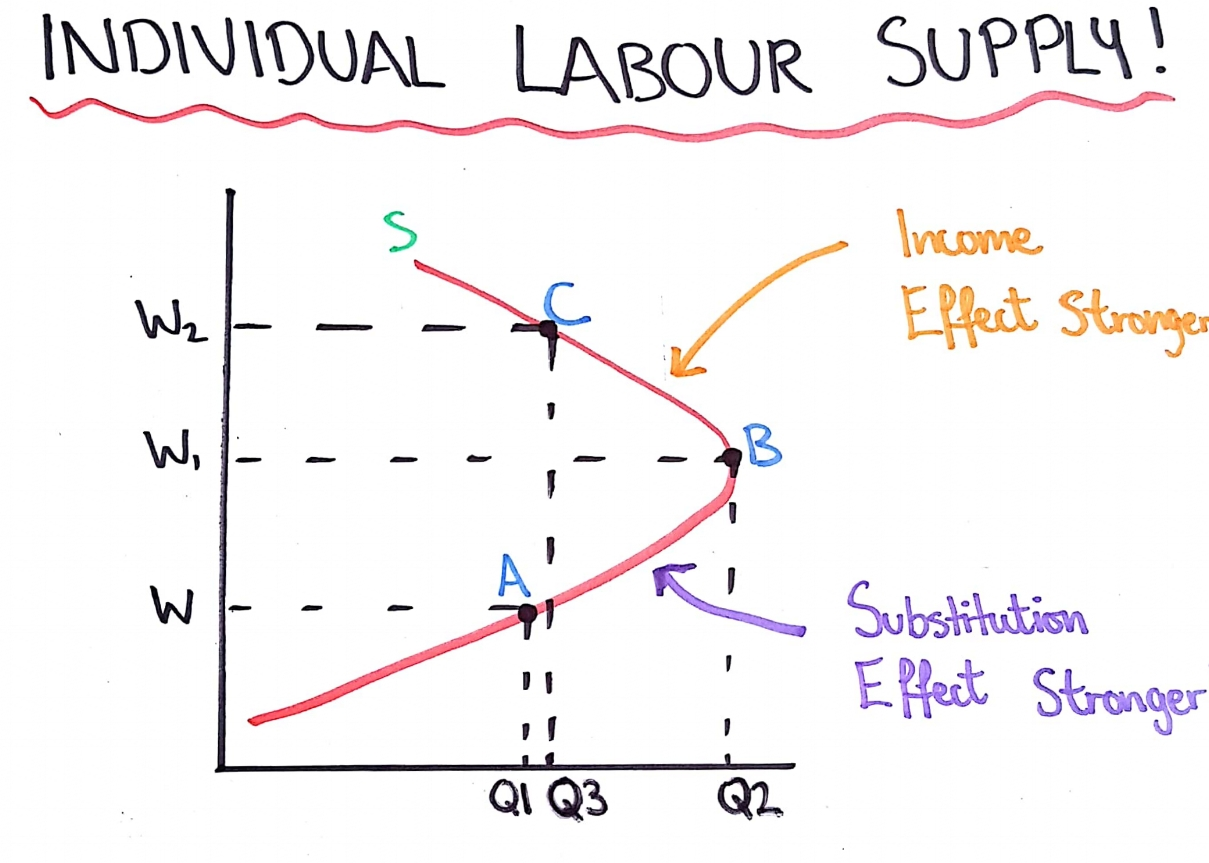3.5 labour markets
1/67
There's no tags or description
Looks like no tags are added yet.
Name | Mastery | Learn | Test | Matching | Spaced |
|---|
No study sessions yet.
68 Terms
Who demands labour in labour markets
Firms
Who supplies labour in labour markets
Individuals
demand for labour definition
the number of workers a firm is willing and able to employ at a given wage rate in a given time period
what is the type of demand for labour
derived demand
labour demand curve

why is the labour demand curve downward sloping
as wage increases, firms will substitute to capital
law of diminishing marginal returns applied to labour market
as extra workers are employed, the extra output from each one decreases
MPPL
Marginal physical product of labour
define MPPL
additional output produced by an extra worker employed
MRPL
marginal revenue product of labour
define MRPL
additional revenue produced by an extra worker employed
when will firms employ a worker
if MRPL is greater than MPPL
eval of MRPL as a theory
can be hard to measure a workers productivity
efficiency wage theory
workers will be more productive if they are paid a higher wage as they are more loyal to their employer, have a better diet and lifestyle making them healthier, which would increase MRPL
Factors that will shift MRPPL / DL curve
-change in labour productivity
-change in marginal revenue
-change in costs of labour
-change in technology changing labour productivity
-change in technology changing usefulness of labour
how would an increase in labour productivity shift MRPPL / DL curve
curve shifts right, as MPP and MRP would increase
how would an increase in marginal revenue shift MRPPL / DL curve
shift right
how would an increase in costs of labour shift MRPPL / DL curve
shift to MRP to the left
how would an increase in technology making workers more productive shift MRPPL / DL curve
shift to the right
how would an increase in technology making workers obsolete shift MRPPL / DL curve
shift to the left
factors influencing demand for labour
confidence in economy
substitutability of labour
wages
stage of economic cycle
government intervention
trade union power
productivity
profitability
costs of other FoPs
demand for the product
factors influencing supply of labour
wealth level
wages in other industries
demographics
immigration
generosity of welfare payments
working conditions
population size
geographical mobility
occupational mobility
non-wage considerations
non-work commitments
qualifications/ skills
wages
WED
wage elasticity of demand for labour
define WED
measures the change in demand for labour when the wage rate changes
equation for WED
% change in quantity of labour demanded/ % change in wage
factors affecting WED
time
substitutability
labour costs as a proportion of total costs
PED of product being made
labour protections
how does time impact WED
in the short term, demand for labour will be more inelastic, as firms cant find alternatives to labour quickly
how does substitutability impact WED
the more substitutable the more wage elastic
how does labour costs as a proportion of total costs affect WED
if labour costs make up a larger proportion of a firms total costs, WED will be more elastic
how does PED of the product being made affect WED
if PED is inelastic, WED will be inelastic, as firms can pass on higher costs of labour to consumers
how does labour protections affect WED
more trade union power will make demand more WED inelastic as it is harder for firms to fire wages after wage changes
define individual labour supply
the total number of hours that a worker will supply at a given wage rate
define occupational labour supply
how many workers are willing to work in a given job at the given wage rate
causes of a movement along the SL curve
real wage rate on offer in the industry plus extra pay
how can factors influencing labour supply be split up
into monetary and non monetary benefits
supply of labour curve for an industry

supply of labour curve for an individual
up to a certain wage, substitution effect is dominant, as the substitute from leisure to work is great
however, over a certain point, the income effect is dominant, as people can achieve the same income by working fewer hours

WES
wage elasticity of labour supply
WES defention
the responsiveness of the labour supply to change in response to a change in the wage rate
WES equation
% change in quantity of labour supplied/ % change in wage rate
determinant of elasticity of labour supply
skills/qualifications
time period
satisfaction/vocation/purpose
mobility of labour
how do skills/qualifications affect WES
lower skilled jobs are more wage elastic, as switching between jobs is easier as there are less barriers to entry
how does time period affect WES
the shorter the time period the less elastic, as people are bounded by contracts and commitments
how does satisfaction/vocation/purpose affect WES
if people find their job more purposeful WES will be less elastic, as people are not mainly in it for the wage
how does mobility of labour affect WES
if labour is more mobile, WES will be more elastic
what can cause market failure in labour markets
geographical and occupational immobility
geographical immobility
when workers are unable or unwilling to locate in the areas where the demand for labour is
causes of geographical immobility in the UK
lack of high speed transport
high housing costs
family/ social ties
solutions to geographical immobility UK
HS2
government subsidies on housing
occupational immobility
when workers have difficulty changing jobs within or between industries as they lack the skills demanded by employers
causes of occupational immobility in the UK
lack of skills actually demanded by the work force
solutions to geographical immobility in the UK
improve apprenticeship options with the apprenticeship levy
policies to increase labour supply in the UK
increase childcare provision
reduce NHS waiting lists through weekend appointments
decrease the level of unemployment benefits
increase the state pension age
increasing the availability of skilled work visas for immigrants
K for increased childcare provision
-currently costs around £7000 part time for for nursery under 2
-decreasing birth rate
-low availability of nursery places
AA for increased childcare provision
increases the hours parents can work
decreases percentage of income spent on childcare
may incentivise a higher birth rate
eval for increased childcare provision
opportunity cost/ higher taxes if government increases subsidy
estimated cost of 5 billion
may still be regional or disability disparities
k for reducing NHS waiting lists through more weekend appointments
6.24 million people on waiting lists, this is still rising
this is expensive to keep up with
aa for reducing NHS waiting lists through more weekend appointments
decrease waiting lists
less people would miss work, which would decrease inactive population and increase productivity
eval for reducing NHS waiting lists through more weekend appointments
could make working conditions for doctors worse, decinetivising training and retention of medical staff, worsening the issue
K of decrease the level of unemployment benefits
joint claimants over 25: around £620 per month
AA of decrease the level of unemployment benefits
incentivises people to work to earn enough to survive, decreasing economic activity
decreases proportion of tax revenue that is spent on benefits, can be invested elsewhere
eval of decrease the level of unemployment benefits
might worsen the quality of life for people with disabilities or health issues preventing them from working
could increase number of people in relative poverty, as many are on benefits as they cannot find work due to structural unemployment
K of increase the state pension age
depends on national insurance record
currently 66 years for men and women, but increases
around £220 a week is full state pension
AA of increase the state pension age
increases output as older workers stay in the economy for longer
decreases government spending on pensions
older workers may have more developed skill sets
eval of increase the state pension age
may decrease productivity due to health and mobility issues
older workers may not be able to keep up with innovations in technology
might not increase time people spend in workforce, as state pension is insignificant to some in comparison to their private pensions, and older people tend to have greater wealth in property